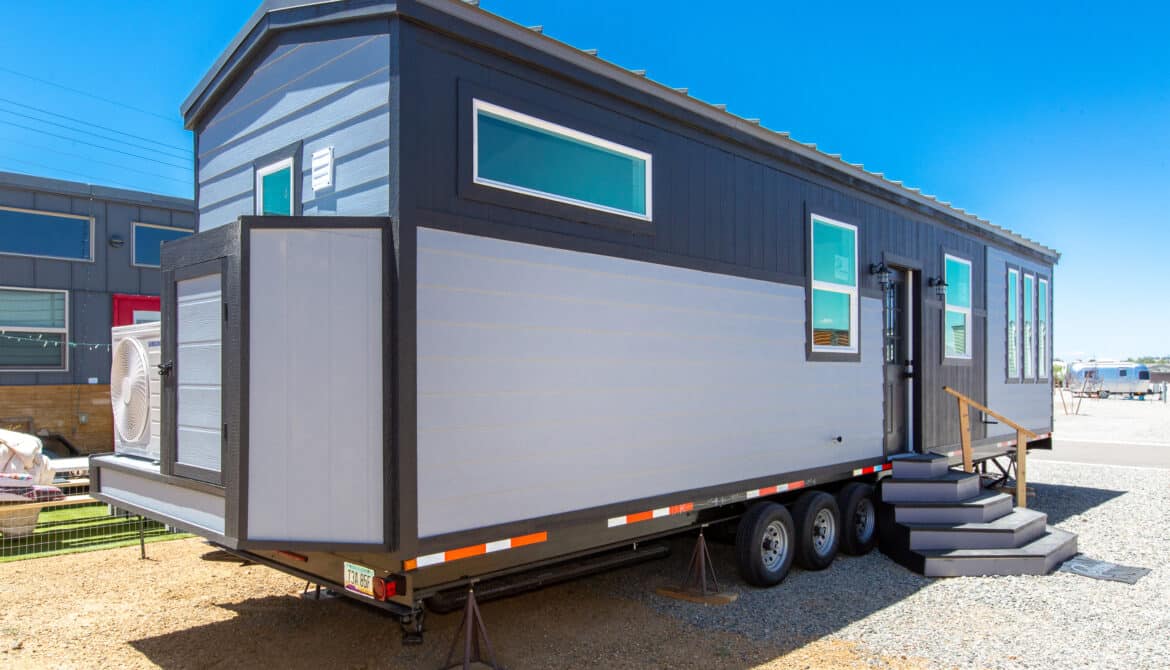Table of Contents
- Design Your Tiny House to be Aerodynamic
- Rethinking the Shape
- Working with an Architect
- Adding Features for Aerodynamics
Building a tiny house is an exciting and rewarding project, but it can also be a challenge. Tiny houses need to be designed and built with the same care as any other home, but they must also take into account the unique challenges of living in a small space. There are many factors to consider when designing and building a tiny house, from aerodynamics to underground construction to hurricane ties. This article will provide an overview of some of the most important considerations for those looking to build a tiny house. We’ll discuss how to design your tiny house for aerodynamics, what you need to know about building underground, how to use hurricane ties effectively, and more. By the end of this article, you should have a better understanding of how to make your tiny house safe and comfortable.
Design Your Tiny House to be Aerodynamic
Aerodynamics is an important consideration when designing a tiny house. By making sure your tiny house is aerodynamic, you can reduce the amount of drag it experiences as it moves through the air. This will make it easier to tow and can also save on fuel costs. Here are some tips for designing your tiny house to be aerodynamic.
Rethinking the Shape
The shape of a tiny house has a big impact on its aerodynamics. A streamlined shape such as a teardrop or egg-shaped design will reduce drag and make it easier to move through the air. If you want to get creative, you can even experiment with shapes like wings or fins that can help create lift and reduce drag.
Working with an Architect
If you’re not comfortable designing your own tiny house, consider working with an architect who specializes in aerodynamic designs. They’ll be able to help you create a unique design that takes into account all the factors that go into making a tiny house aerodynamic.
Adding Features for Aerodynamics
When designing an aerodynamic tiny house, there are some features that can help reduce drag and improve performance. Adding curved surfaces and tapering edges can help reduce turbulence around the edges of the house. You should also consider adding features such as spoilers, diffusers, and vortex generators which can help create downforce and reduce drag.
Finally, when building your tiny house, make sure all seams are properly sealed so that air does not leak out from any gaps or cracks in the structure. This will ensure that your tiny house is as efficient as possible when moving through the air.
With these tips in mind, you should be able to design an aerodynamic tiny house that performs well and looks great too!
Build Underground
Building a tiny house underground can be a great way to save on energy and construction costs while also providing an interesting and unique living space. There are several ways to go about building a tiny house below ground, depending on your desired outcome.
Building a House into the Earth
The most common way of building a house into the earth is by digging down into the soil and then constructing walls and floors as you would with any other type of home. This option requires careful planning and engineering to ensure that the structure is safe and secure. It’s important to consider drainage, waterproofing, insulation, ventilation, and any potential hazards such as flooding or seismic activity. Additionally, it’s important to take into account local building codes when constructing an underground home.
Building a Bomb or Survival Shelter
For those looking for an extreme form of protection from natural disasters or other threats, building a bomb or survival shelter may be an option. These shelters are usually constructed using reinforced concrete or steel-reinforced concrete in order to provide maximum protection against outside threats. They are typically outfitted with basic amenities such as air filtration systems, communication equipment, food storage areas, and sleeping quarters.
Building a Basement
A basement can be a great way to add extra living space to your tiny house without having to build up aboveground. Basements are typically dug out by hand or with machinery depending on the size of the project. It’s important to consider waterproofing measures such as sump pumps and drainage systems in order to prevent moisture from entering the home. Additionally, it’s important to take into account local building codes when constructing a basement in order to ensure that all safety protocols are met.
Building underground can be an excellent way to save money while creating an interesting living space for your tiny house. With careful planning and consideration of local building codes, you can create a safe and secure home that will last for years to come.
Use Hurricane Ties
When designing and building your tiny house, it is important to consider the potential for extreme weather. If you live in a region that is prone to hurricanes or other severe storms, it is essential that you use hurricane ties to secure your home’s structure. Hurricane ties are metal straps or clips that attach the roof rafters to the walls of your tiny house. This helps to ensure that your home does not collapse during high winds or heavy rains.
Hurricane ties come in various sizes and shapes so it is important to choose the right ones for your tiny house. It is also important to make sure they are installed correctly and securely. If you are unsure about how to install them, it may be best to hire a professional contractor who can do the job properly. Additionally, it is important to check local building codes as some areas may require additional reinforcements for hurricane-prone regions.

Installing Hurricane Ties
Installing hurricane ties is fairly easy once you have chosen the right size and type for your tiny house. You will need to measure the distance between each roof rafter and wall stud and then cut the hurricane tie accordingly. Once all of the pieces are cut, use a drill with screws to attach them securely into place. Make sure that all of the joints are tight so that there is no movement when they are exposed to strong winds or heavy rains.
Inspecting Your Work
Once you have finished installing hurricane ties, it is important to inspect them regularly in order to ensure they remain secure and functional. Check for any signs of wear or tear and replace any damaged pieces as soon as possible. Additionally, if you live in an area with frequent storms, it may be a good idea to reinforce your hurricane ties with additional screws or bolts every few years. By taking these steps, you can rest assured knowing that your tiny house will remain safe during severe weather conditions.
Hurricane ties secure tiny house roofs from extreme weather; easy to install with screws; inspect regularly for wear and tear.
Don’t Forget About Your Porch and Outbuildings
While you’re busy designing and building your tiny house, don’t forget about the porch or any outbuildings that are part of the plan. Porches and outbuildings can be a great way to add living space to your tiny house without taking up too much of the lot size. They can also provide a great spot to relax in the shade or enjoy a sunset.
Building a Porch
When building a porch for your tiny house, it is important to consider how much weight it will need to support. If you plan on having furniture on the porch, make sure that you use materials that are strong enough to hold the weight of those items. It is also important to consider how much sun exposure the porch will get so that you can choose materials that won’t fade quickly over time.
Outbuildings
Outbuildings like sheds, workshops, and storage units can be a great addition to your tiny house. These structures should be built with hurricane ties and other strong materials so they can withstand strong winds during storms. Make sure that these buildings are also properly secured so they don’t become projectiles during high wind events.
Inspections
Once your porch and outbuildings are constructed, it is important to have them inspected by an engineer or contractor who specializes in tiny houses. This will ensure that everything is built according to code and is structurally sound. It’s also important to remember that any additions made to your home may require additional permits from local authorities before construction begins.
Overall, porches and outbuildings can be a great way to expand the living space of your tiny house while still keeping it safe during storms. By following these tips, you can make sure that your new additions are built safely and securely for years of enjoyment!
Move Your Tiny House
Moving a tiny house is no small feat, and it requires planning and preparation. It’s important to understand the challenges of moving a tiny house before attempting it. Here are some tips for making sure your move goes smoothly.
Research Moving Companies
The first step in moving your tiny house is to research moving companies. Look for companies that specialize in moving tiny houses, as they will have the experience and equipment necessary to do the job safely and efficiently. Ask about their insurance policies, as well as any additional fees or services they may offer. Also, make sure you get quotes from multiple companies so you can compare prices and services.
Check Local Regulations
Before attempting to move your tiny house, check with local authorities to ensure that it is legal to move it within the area. Some areas may have restrictions on how far away a tiny house can be moved, or if it needs to be inspected beforehand. Additionally, check to see if there are any permits required for moving a tiny house in your area.
Prepare Your Tiny House
Once you’ve found a company and obtained all necessary permits, it’s time to prepare your tiny house for its journey. Make sure all windows and doors are securely shut and locked before loading the house onto the truck or trailer. Additionally, inspect all electrical wiring and plumbing connections for any signs of damage or wear. If possible, disconnect all utilities such as electricity and water before the move begins.
Secure Your Tiny House During Transport
When transporting your tiny house, make sure that it is securely fastened down with straps or chains so that it does not shift during transport. This will help prevent any damage from occurring while en route to its destination. Additionally, always use caution when driving behind a trailer carrying a tiny house; keep plenty of space between your vehicle and the trailer in case of sudden stops or turns.
Moving a tiny house can be an exciting experience but also requires careful planning and preparation beforehand. By researching moving companies, checking local regulations, preparing your tiny house for transport, and securing it during transit, you can ensure that your move goes off without a hitch!
Conclusion
Building a tiny house that is aerodynamic and able to withstand extreme weather conditions is an achievable goal. The key to success is to plan ahead, take the time to research the best materials, and work with experts who can help you make sure your tiny house meets all of the necessary safety requirements. Rethinking the shape of your tiny house and building it underground are two great ways to ensure its durability in extreme weather. You should also consider using hurricane ties, as well as giving thought to your porch and outbuildings. Finally, when it comes time to move your tiny house, be sure to hire a professional mover who has experience with this type of job.
By taking these steps, you can rest assured that your tiny house will be able to withstand whatever Mother Nature throws at it!


